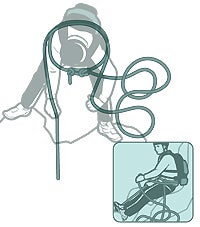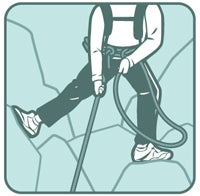Heading out the door? Read this article on the new Outside+ app available now on iOS devices for members! Download the app.
Assess the Snow
“In spring, the days are longer and temps rise—so heat penetrates the snowpack more deeply,” says Caroline George, a Utah-based guide. That can saturate layers, destabilizing the snowpack and increasing the risk of avalanches. In these conditions, slopes are safest in the morning, after cold overnight temps have refrozen and consolidated the snow. Travel before 11 a.m., when the sun starts turning the surface snow to slush. “If you’re sinking in farther than your boot top, it’s time to get off the steep slopes,” says Andrew Councell, a Colorado-based guide. Here’s how to handle a day up high:
>> Weather Check the forecast and recent conditions through local reports. Avalanche risk increases after several warm days and overcast nights in a row, or after spring storms dump fresh snow or rain on top of older, crusty layers.
>> Angle “Spring snow can produce slides at lower angles than in winter,” says George. Late-season slides occur most often on slopes between 27 and 45 degrees. Pack an inclinometer to check angles accurately; we like Backcountry Access’s Slope Meter ($24).
>> Terrain East- and southeast-facing slopes soften before those facing west or southwest, because the sun hits them first. Leeward slopes are also less stable than windward aspects.
Ascend
Switchback up softer spring slopes by kicking flat, evenly spaced steps into the snow with the toe of your boot. Prevent a serious fall with a self-belay: Holding your axe in your uphill hand, plunge the spike and shaft into the snow. Take two steps forward. When you’re in a balanced position—uphill leg bent in front of you, downhill leg straight—pull out the shaft and replant. To turn, plunge the spike into the snow and plant your feet in a level, duck-footed stance, facing up. Switch hands and swing the new uphill foot forward in the new direction before moving the axe up. Run into a short icy section? Use your ice axe, not your feet, to chop a few steps, says Councell.
Stop Any Fall with Self-Arrest
On gentle slopes, head straight down instead of traversing diagonally, says Councell. On steep descents, switchback down, plunging your heels into the snow in a rhythm and keeping your knees slightly bent. Hold your axe in the uphill hand and plant the shaft for balance and self-belay.
Feet first on your back Hold the axe diagonally across your chest—one hand gripping the shaft and the other gripping the head, near your ear. Roll toward the pick and flip onto your stomach. Press all of your weight onto the pick to dig it into the snow and kick your toes into the slope to stop.

Headfirst on your stomach Reach forward and to the side and dig the pick into the snow. Pivot around the axe head and dig in with your toes.

Headfirst on your back Dig the pick into the snow at your hip. Twist onto your stomach and let your legs swing around to get in position to stop.

Descend
On gentle slopes, head straight down instead of traversing diagonally, says Councell. On steep descents, switchback down, plunging your heels into the snow in a rhythm and keeping your knees slightly bent. Hold your axe in the uphill hand and plant the shaft for balance and self-belay.
Glissade
If you’re descending a rock-free slope with a safe runout, sliding down the snow is much faster (and more fun) than walking. Councell’s preferred method: Sit down and slide on your feet and butt. Place one hand on your axe’s head (pinkie toward the pick) and the other on the shaft at your hip. Press the spike into the snow at your side to steer and slow down. (Note: Never glissade in crampons; the points can catch in the snow and make you lose control.)
